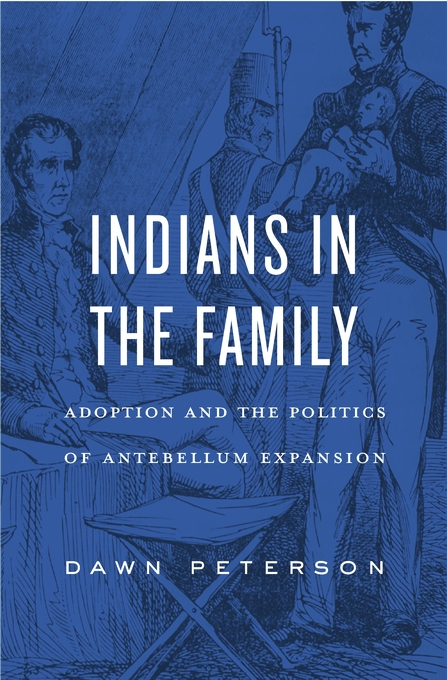
Indians in the Family: Adoption and the Politics of Antebellum Expansion
 Dawn Peterson is an assistant professor of early North American and U.S. history at Emory University. She is the author of the new book Indians in the Family: Adoption and the Politics of Antebellum Expansion (Harvard Univ. Press, 2017).
Dawn Peterson is an assistant professor of early North American and U.S. history at Emory University. She is the author of the new book Indians in the Family: Adoption and the Politics of Antebellum Expansion (Harvard Univ. Press, 2017).
In 1813, Andrew Jackson invaded the Upper Creek Nation (in what is now the state of Alabama), ordered his troops to “destroy” an entire village of approximately 300 people, and then, in the aftermath, sent a surviving Creek infant home to his plantation household. He told his wife that he felt an “unusual sympathy” for the orphaned child and ordered his son to “adopt” the boy into the family. The child came to be called Lyncoya and lived in Jackson’s plantation household in Nashville for nearly 15 years before dying of tuberculosis around the age of 16. While Andrew Jackson characterized his feelings for Lyncoya as “unusual,” his behavior reveals an understudied post-Revolutionary phenomenon. Between the U.S. Revolution and the Indian Removal Act of 1830, a number of prominent U.S. whites, many of whom were slaveholders, incorporated American Indian children into their homes.
For white adopters, incorporating Native youths in their homes coincided with federal initiatives aimed at assimilating Indian people—and their lands—into the United States’ expanding national borders. In the face of highly organized pan-Indian resistance movements and longstanding transatlantic Native commercial and military alliances, Jeffersonian “civilization” policies emphasized the utility of using non-military strategies to incorporate Indian nations into the United States’ free white populace. Influenced by such popular initiatives, prominent white men—and in a few cases, women—saw their own familial homes as schools in which to educate Native boys and girls in the patriarchal property values, nuclear family structures, and male-headed agricultural practices that underpinned white male citizenship in a pro-slavery settler democracy.
Yet, this is only one part of the story. Many of the children living in white homes were actually sent there by influential Native guardians, who had their own aims in mind. As the United States tried to claim Indian lands for “white” settlement between the 1790s and 1830, this select group of American Indian women and men utilized whites’ adoptive desires to expose children to the language and literacy skills and economic cultures that would potentially support Native sovereignty struggles. By the early 1800s, a small group of Southeast Indians saw white slaveholders’ interests in incorporating Native boys into their plantation homes as especially useful. As U.S. planters rapidly invaded Southeast Indian homelands, these Choctaw, Chickasaw, and Creek women and men sent sons to live in slaveholding households to learn the plantation educations that supported political and economic power in an expanding slaveholding South. In so doing, they hoped to use racial slavery as a means to empower themselves, their sons, and their tribal nations against the white slaveholders who coveted their homelands.
The complex array of commitments exhibited by white adopters, Native guardians, and adopted children reveals the ways that U.S. whites and American Indian people engaged ideas about kinship in the service of both empire and resistance. Even further, it demonstrates how a set of racialized and kin-based ideologies prioritizing white settlement and racial slavery both inspired adoptive impulses on the part of late eighteenth- and early nineteenth-century elites and set the stage for the territorial contests that would come to a head in the War of 1812 and finally culminate in the Indian Removal Act of 1830. At first, prominent U.S. whites believed that adopting Indians into white families—and, indeed, into a free white “national family”—seemed the most humane and efficient means to open Indian lands for white settlement and plantation slavery. Yet this plan began to deteriorate during the War of 1812. The war by and large ended Indian people’s trans-Atlantic affiliations and effectively crushed pan-Indian military alliances. Even still, Indian people continued to resist incorporation into the United States. Indeed, even adopted and putatively assimilated Indian men and women did not act as U.S. whites hoped they would. These youth frequently returned to their tribal nations, where they supported autonomous indigenous economies and state formations, which, in the Southeast, became increasingly based on the slave-driven production of export agriculture. Scrambling to foreclose upon these pro-slavery sovereignties in the 1820s, leading whites began to eschew Jeffersonian assimilation initiatives, calling for Indians’ expulsion to lands west of the Mississippi. Andrew Jackson himself famously led this charge. According to the logics of his 1830 Removal Act, if Indians refused to join the United States as adopted and assimilated subjects, then they had to leave their eastern homelands.
As our current president seeks to recover the supposedly humanitarian propensities of men like Andrew Jackson, the stories of white adoptions of Native American youths importantly highlight the violence that underpinned everyday interactions between Jackson and other prominent antebellum whites and the people of American Indian and African descent they sought to dominate and control. Indeed, rather than white adopters of Native children acting benevolently, U.S. whites proceeded in ways that they believed would secure their racial authority. In their scramble to maintain white supremacy both within and outside of their homes, however, white adopters unintentionally enabled new Native resistance strategies, ones that would subsequently reshape antebellum federal Indian policy, giving it some of the very contours that persist it to this day.
